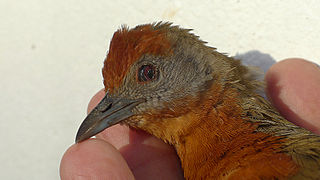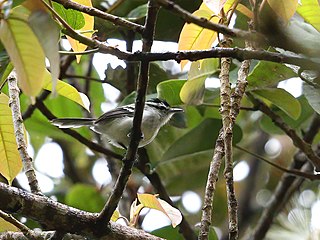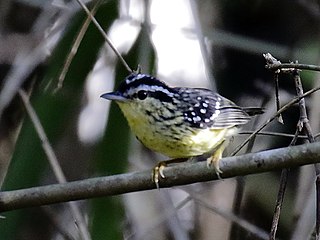
The rufous-breasted wren is a small songbird of the family Troglodytidae. It is found in Colombia, Costa Rica, Panama, Trinidad and Tobago, and Venezuela.

The collared inca is a species of hummingbird found in humid Andean forests from western Venezuela through Colombia and Ecuador to Peru. It is very distinctive in having a white chest-patch and white on the tail. Like other hummingbirds it takes energy from flower nectar, while the plant benefits from the symbiotic relationship by being pollinated. Its protein source is small arthropods such as insects. It is normally solitary and can be found at varying heights above the ground, often in the open.

The russet-crowned crake is a species of bird in subfamily Rallinae of family Rallidae, the rails, gallinules, and coots. It is found in Bolivia, Brazil, Colombia, Ecuador, the Guianas, Paraguay, Peru, and Venezuela.

The striated antbird is a species of bird in subfamily Thamnophilinae of family Thamnophilidae, the "typical antbirds". It is found in Bolivia, Brazil, Colombia, Ecuador, and Peru.

The ochre-breasted antpitta is a species of bird in the family Grallariidae. It is found in Bolivia, Colombia, Costa Rica, Ecuador, Panama, and Peru.

The ochre-fronted antpitta is a Vulnerable species of bird in the family Grallariidae. It is endemic to Peru.

The creamy-bellied antwren is a species of bird in subfamily Thamnophilinae of family Thamnophilidae, the "typical antbirds". It is endemic to Peru.

The southern nightingale-wren, also known as the scaly-breasted wren, is a species of bird in the family Troglodytidae. It is found in Bolivia, Brazil, Colombia, Costa Rica, Ecuador, Panama, Peru, and Venezuela.

The collared antshrike is a species of bird in subfamily Thamnophilinae of family Thamnophilidae, the "typical antbirds". It is found in Ecuador and Peru.

The plain-tailed wren is a species of songbird in the family Troglodytidae. It has a mostly rufous body with a gray, black, and white striped head. It is found in the Andes of southern Colombia, Ecuador, and northern Peru. Its natural habitat is subtropical or tropical moist montane forests. Plain-tailed wrens are so-called bamboo specialists and live almost exclusively in chusquea bamboo thickets. Like other wrens, its diet consists mainly of insects with some seeds and berries.

The black-bellied wren is a species of bird in the family Troglodytidae. It is found in Colombia, Costa Rica, and Panama.

The moustached wren is a species of bird in the family Troglodytidae. It is found in Bolivia, Brazil, and Peru.

The spot-breasted wren is a species of bird in the family Troglodytidae. It is found in Belize, Costa Rica, El Salvador, Guatemala, Honduras, Mexico, and Nicaragua.

The speckle-breasted wren is a species of bird in the family Troglodytidae. It is found in Colombia, Ecuador, and Peru.

The sooty-headed wren is a species of bird in the family Troglodytidae. It is found in Colombia and Panama.

The ocellated piculet is a species of bird in subfamily Picumninae of the woodpecker family Picidae. It is found in Bolivia and Peru and possibly Argentina.

The rufous-breasted piculet is a species of bird in subfamily Picumninae of the woodpecker family Picidae. It is found in Bolivia, Brazil, Colombia, Ecuador, and Peru.

The yellow-breasted warbling antbird or yellow-breasted antwarbler, is a species of bird in subfamily Thamnophilinae of family Thamnophilidae, the "typical antbirds". It is found in Bolivia, Brazil, and Peru.

The curve-winged sabrewing is a species of hummingbird in the "emeralds", tribe Trochilini of subfamily Trochilinae. It is endemic to Mexico.

The streak-headed antbird is a species of bird in subfamily Thamnophilinae of family Thamnophilidae, the "typical antbirds". It is found in Bolivia, Colombia, Ecuador, and Peru.





















